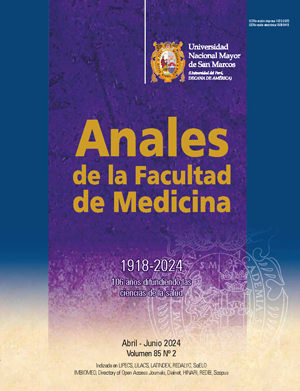Costos anuales incrementales para implementar intervenciones efectivas que erradiquen el hambre en el mundo y en Perú
DOI:
https://doi.org/10.15381/anales.v85i2.28429Palabras clave:
Hambre, Inseguridad Alimentaria, Perú, Política Pública de Salud, Costos y Análisis de CostoResumen
Desde 2018, la inseguridad alimentaria ha aumentado significativamente en el mundo, especialmente en América Latina, el Caribe y Perú, debido a conflictos, la pandemia de COVID-19, bajo crecimiento económico, inflación, pobreza, desigualdad y shocks climáticos. Estas condiciones dificultan alcanzar la meta de erradicar el hambre para 2030, subrayando la importancia de centrar los recursos en la seguridad alimentaria y nutricional. Este artículo revisa investigaciones que identifican intervenciones efectivas y los costos adicionales necesarios para erradicar el hambre en el mundo para 2030. En Perú, se propone un portafolio de 10 intervenciones efectivas, requiriendo una inversión anual adicional de 393,3 millones de dólares para sacar del hambre a 2,4 millones de personas. Esta inversión se distribuye en 50,4 millones para sistemas alimentarios, 259 millones para resiliencia climática, 45,8 millones para protección social y 38,5 millones para infraestructura rural.
Descargas
Publicado
Número
Sección
Licencia
Derechos de autor 2024 Anales de la Facultad de Medicina

Esta obra está bajo una licencia internacional Creative Commons Atribución-NoComercial-CompartirIgual 4.0.
Aquellos autores/as que tengan publicaciones con esta revista, aceptan los términos siguientes:
- Los autores/as conservarán sus derechos de autor y garantizarán a la revista el derecho de primera publicación de su obra, el cuál estará simultáneamente sujeto a la Licencia de reconocimiento de Creative Commons que permite a terceros compartir la obra siempre que se indique su autor y su primera publicación esta revista.
- Los autores/as podrán adoptar otros acuerdos de licencia no exclusiva de distribución de la versión de la obra publicada (p. ej.: depositarla en un archivo telemático institucional o publicarla en un volumen monográfico) siempre que se indique la publicación inicial en esta revista.
- Se permite y recomienda a los autores/as difundir su obra a través de Internet (p. ej.: en archivos telemáticos institucionales o en su página web) antes y durante el proceso de envío, lo cual puede producir intercambios interesantes y aumentar las citas de la obra publicada. (Véase El efecto del acceso abierto).



